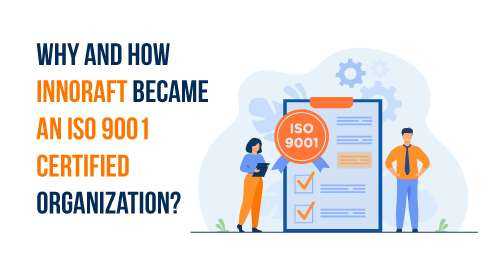
Why and How Innoraft became an ISO 9001 certified organization
What is ISO 9001 certification?
The ISO certification determines that an organization meets a set of prescribed standards that will help them meeting customer and other stakeholder needs within statutory and regulatory requirements related to a product or service.
The standard is focused mainly on 7 quality management principles, which include customer focus operations, the involvement of top management, and a process of consistent improvement.
The seven quality management principles are:
- Customer Orientation
- Leadership
- Engagement of people
- Process approach
- Consistent Improvement
- Evidence-based decision making
- Relationship management
Why did we pursue the ISO 9001 certification?
We read all about it and figured that ISO 9001 certification provides objective proof to our employees, partners, clients, and the outside world that we are a process-oriented company and customer satisfaction is at the core of our business.
We had some key expectations from pursuing the ISO 9001 certification:
- Credibility Enhancement: Often for largescale enterprises and also for public sector enterprises, choosing a vendor requires sets of qualification parameters and mandatory certification. The ISO 9001 certification is a major requisite among those.
- Customer Satisfaction: The set of processes implemented in the organization due to the ISO 9001 certification will help us to better understand customers’ needs, reduce errors, and will eventually increase customer confidence in our ability.
- Higher operating efficiency: By implementing the best practices from our industry, better management of all our client projects, process optimization techniques, and increasing our focus on quality we will not only reduce the operational costs, but also increase our efficiency.
- Decision-making Capability: With the right organizational structure and processes in place, we can better detect and identify problems in a quick and efficient way. This will eventually help us to take not just quick but also apt decisions.
- Enhanced Employee Engagement: Improved internal communications by putting strings into the system will help us to ensure that employees working on any project are well aware of the big picture and can accordingly engage with the management. Moreover, involving employees in major processes will help them to acquire good knowledge.
- Better Process Integration: We have analyzed that by effective process interactions we will be able to improve efficiency levels more easily, thereby reducing errors and benefiting from cost savings.
- Consistent Improvement: This was a major factor that caused us to go for this certification was our stride for consistent and steady improvement. We were able to understand that by implementing the prescribed processes there will be a steady and incremental enhancement in our operation management and delivery.
- Scope of Increasing Revenue: Leveraging the reputation of ISO 9001 can help us to win tenders and contracts, besides, increasing efficiency will help to gain customer satisfaction and retention.
Here is how we hit the Bull’s Eye?
Choosing an ISO Certification Body
As ISO itself does not provide certification to the companies so we had to look out for external bodies. It was very important for us to choose a recognized and credible certification body. While choosing the agency we had
- Evaluated several ISO Certification service providers.
- Checked if they are following the CASCO standards.
- Checked whether they are accredited or not.
Gap Analysis
A consultant visited our offices to review and document our current processes and procedures, then highlighted any areas that did not meet the requirements of the standard.
Plan of Action
After the ISO auditor identified the existing gaps in our organization, we prepared an action plan to eliminate these gaps. We have prepared the list of the required tasks to be done to bring the desired modification to our organization.
Auditing
The certification audit was done in two stages.
Stage-1: The ISO auditor checked the modifications we had done. The auditor identified the non-conformities and guided us with procedures to achieve the desired quality management system. We assessed all these non-conformities and get them aligned as per the desired quality standards through modification in the techniques and processes.
Stage-2: After all the required changes were completed, the ISO auditor did the final auditing. He checked whether all the non-conformities were eliminated or if there are any parameters which were not matching the ISO quality standards. Once he was completely satisfied a final audit report was prepared and submitted to the concerned authority.
Completing the ISO Certification
The certification issuing authority minutely reviewed the audit report and found it satisfactory. After that, the authority issued the ISO9001 certification.
What does it mean for Innoraft?
Becoming an ISO 9001certified organization was on Innoraft’s agenda for a long time. We were determined that if we are going to add this feather to our crown, we will get it done in the most authentic way and by implementing all the necessary procedures besides, qualifying each and every step. Our dreams just got bigger and we are now going to shoot for the stars.





